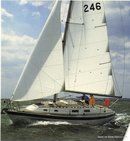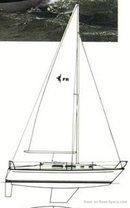Fulmar 32 Fin keel
Sailboat specifications
The Fulmar 32 is a 31’10” (9.7m) cruiser-racer sailboat designed by Dubois Naval Architects (United Kingdom). She was built between 1980 and 1991 by Westerly (United Kingdom) with 435 hulls completed. The Fin keel version features an L-shaped keel providing a good performance/price trade-off.
The Fulmar 32 is as well listed, on Boat-Specs.com, in Twin keel and Keel and centerboard version (see all the versions compared).
The Fulmar 32 is as well listed, on Boat-Specs.com, in Twin keel and Keel and centerboard version (see all the versions compared).
Fulmar 32's main features
- Model
- Fulmar 32
- Version
- Fin keel
- Hull type
- Monohull
- Category
- Cruiser-racer sailboat
- Sailboat builder
- Sailboat designer
- Country
- United Kingdom
- Construction
- Hull and deck: GRP (glass reinforced polyester)
- Number of hulls built
- 435
- First built hull
- 1980
- Last built hull
- 1991
- Appendages
- Keel : fin without bulb
- Helm
- Single tiller
- Rudder
- Single spade rudder
- Unsinkable
- No
- Trailerable
- No
- Standard public price ex. VAT (indicative only)
- N/A €
Fulmar 32's main dimensions
- Hull length
- 31’ 10”9.7 m
- Waterline length
- 26’7.92 m
- Beam (width)
- 10’ 11”3.33 m
- Draft
- 5’ 2”1.6 m
- Mast height from DWL
- 42’ 6”12.96 m
- Light displacement (MLC)
- 9899 lb4490 kg
- Ballast weight
- 4211 lb1910 kg
- Ballast type
- Cast iron
Fulmar 32's rig and sails
- Upwind sail area
- 566 ft²52.6 m²
- Downwind sail area
- 1013 ft²94.11 m²
- Mainsail area
- 253 ft²23.5 m²
- Genoa area
- 313 ft²29.1 m²
- Solent area
- 254 ft²23.6 m²
- Jib area
- 194 ft²18 m²
- Stormjib area
- 93 ft²8.6 m²
- Symmetric spinnaker area
- 760 ft²70.61 m²
- IiFore triangle height (from mast foot to fore stay top attachment)
- 36’ 7”11.15 m
- JiFore triangle base (from mast foot to bottom of forestay)
- 11’ 11”3.62 m
- PiMainsail hoist measurement (from tack to head)
- 41’ 6”12.65 m
- EiMainsail foot measurement (from tack to clew)
- 12’ 4”3.75 m
- Rigging type
- Sloop Marconi 7/8
- Mast configuration
- Deck stepped mast
- Rotating spars
- No
- Number of levels of spreaders
- 1
- Spreaders angle
- Swept-back
- Spars construction
- Aluminum spars
- Standing rigging
- 1x19 strand wire continuous
Fulmar 32's performances
- HN (French rating)iHN or "Handicap Nationale" is an empirical rating system used in France allowing various monohulls, of different sizes and designs, to race each other fairly. It is particularly suitable for cruiser and cruiser-racer. Therefore, by comparing these values, we can have an indication of the relative speed of 2 boats.
- 14.0
- Upwind sail area to displacementiThe ratio sail area to displacement is obtained by dividing the sail area by the boat's displaced volume to the power two-thirds.
The ratio sail area to displacement can be used to compare the relative sail plan of different sailboats no matter what their size.
Upwind: under 18 the ratio indicates a cruise oriented sailboat with limited performances especially in light wind, while over 25 it indicates a fast sailboat. - 208 ft²/T19.33 m²/T
- Downwind sail area to displacementiThe ratio sail area to displacement is obtained by dividing the sail area by the boat's displaced volume to the power two-thirds.
The ratio sail area to displacement can be used to compare the relative sail plan of different sailboats no matter what their size. - 372 ft²/T34.58 m²/T
- Displacement-length ratio (DLR)iThe Displacement Length Ratio (DLR) is a figure that points out the boat's weight compared to its waterline length. The DLR is obtained by dividing the boat's displacement in tons by the cube of one one-hundredth of the waterline length (in feet).
The DLR can be used to compare the relative mass of different sailboats no matter what their length:
a DLR less than 180 is indicative of a really light sailboat (race boat made for planning), while a DLR greater than 300 is indicative of a heavy cruising sailboat. - 256
- Ballast ratioiThe Ballast ratio is an indicator of stability; it is obtained by dividing the boat's displacement by the mass of the ballast. Since the stability depends also of the hull shapes and the position of the center of gravity, only the boats with similar ballast arrangements and hull shapes should be compared.
The higher the ballast ratio is, the greater is the stability. - 43 %
- Critical hull speediAs a ship moves in the water, it creates standing waves that oppose its movement. This effect increases dramatically the resistance when the boat reaches a speed-length ratio (speed-length ratio is the ratio between the speed in knots and the square root of the waterline length in feet) of about 1.2 (corresponding to a Froude Number of 0.35) . This very sharp rise in resistance, between speed-length ratio of 1.2 to 1.5, is insurmountable for heavy sailboats and so becomes an apparent barrier. This leads to the concept of "hull speed".
The hull speed is obtained by multiplying the square root of the waterline length (in feet) by 1.34. - 6.83 knots
Fulmar 32's auxiliary engine
- Engine(s)
- 1 inboard engine
- Fuel type
- Diesel
- Fuel tank capacity
- 23.8 gal90 liters
Fulmar 32's accommodations and layout
- Cockpit
- Closed aft cockpit
- Cabin(s)
- 1
- Berth(s) (min./max.)
- 4 / 7
- Head(s)
- 1
- Freshwater tank capacity
- 35.7 gal135 liters
Similar sailboats that may interest you:
Sailboats
First built hull
Hull length
1983
27’ 11”8.5 m
1986
31’ 6”9.6 m
1980
31’ 10”9.7 m
1977
28’ 11”8.8 m
1971
30’9.14 m
1979
29’ 10”9.07 m
1980
35’ 2”10.72 m
1983
27’ 11”8.5 m
1989
30’ 4”9.25 m
1981
30’ 4”9.25 m
1985
29’ 11”9.1 m
1984
30’ 8”9.35 m
1977
28’ 11”8.8 m
1981
30’ 4”9.25 m
1986
31’ 6”9.6 m


